
Republic XF-12 Rainbow |
(Download a higher resolution picture by clicking on any
picture below.) 
The Republic XF-12 Rainbow was a high speed, high altitude reconnaissance airplane powered by four 3,000 horsepower R-4360 radial engines. It was able to cruise at over 450 miles per hour with a service ceiling of 45,000 feet.
 Republic XF-12 Rainbow line drawing.
Republic XF-12 Rainbow line drawing.
The fuselage contained three separate camera compartments with facilites to process film in flight. Eighteen high-intensity flash bulbs were stowed in a hold in the belly for night photography.
The Rainbow had one of the highest power to weight ratios of any multi-reciprocating-engine airplane. It could maintain a sea-level rate of climb of 1,680 feet per minute on three engines and 320 feet per minute on just two engines.
Two prototypes of the Rainbow were built. They carried Army Air Force serial numbers 44-91002 and 44-91003.
When the Rainbow first flew on February 4, 1946, the Army Air Force used the letter F to designate reconnaissance airplanes (F stood for Foto) and the letter P for fighter planes (P stood for Pursuit). In 1947 the Air Force changed their designation system so that the letter F was used to designate Fighter airplanes and the letter R was used to designate Reconnaissance airplanes. The XF-12s were redesignated XR-12 for the remainder of their careers.
The most famous accomplishment of the Rainbow was operation "Bird's Eye". On September 1, 1948, the second XR-12, 44-91003 took off from Edwards Air Force Base and headed out to sea. It climbed to 40,000 feet altitude and turned to the east. Its crew shot 390 photos on a continuous 325-foot long strip of film as it crossed the country in six hours and fifty-five minutes, landing at Mitchel Field, Long Island, New York.
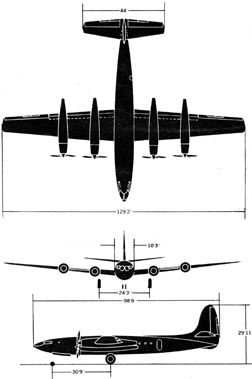 Republic XF-12 Rainbow three-view drawing from the January 1946
issue of Air News.
Republic XF-12 Rainbow three-view drawing from the January 1946
issue of Air News.
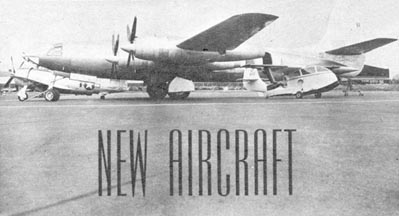 Prototype Republic XF-12 Rainbow, 44-91002 posed with a P-47
Thunderbolt and an amphibious Seabea.
Prototype Republic XF-12 Rainbow, 44-91002 posed with a P-47
Thunderbolt and an amphibious Seabea.
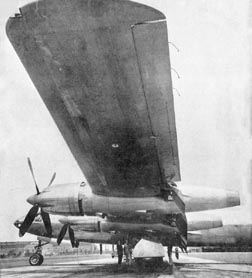 The
engine nacelles of the Rainbow were completely free from
extraneous protuberences.
The
engine nacelles of the Rainbow were completely free from
extraneous protuberences.
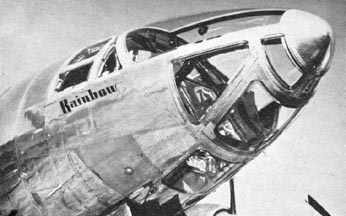 The
nose of the Rainbow was as cleanly streamlined as any airplane.
On take-off and landing, the two halves of the streamlined upper
windscreen rotated down into the nose to provide an unobstructed
view for the pilots through a second flat windscreen
The
nose of the Rainbow was as cleanly streamlined as any airplane.
On take-off and landing, the two halves of the streamlined upper
windscreen rotated down into the nose to provide an unobstructed
view for the pilots through a second flat windscreen
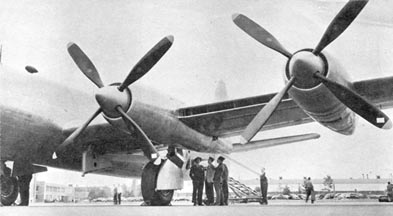 The
engine nacelles of the Rainbow were designed to direct the
exhaust directly to the rear to take advantage of the extra
thrust.
The
engine nacelles of the Rainbow were designed to direct the
exhaust directly to the rear to take advantage of the extra
thrust.
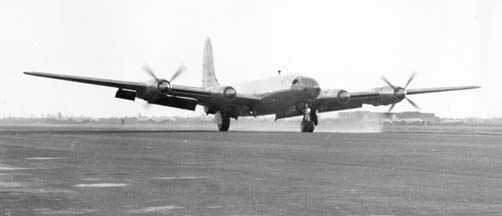 Taxi test of the Rainbow, 44-91002
at Farmingdale, New York. The inboard propellers have been set to
reverse pitch to reduce the landing distance. Republic Photo via
Leo Newman.
Taxi test of the Rainbow, 44-91002
at Farmingdale, New York. The inboard propellers have been set to
reverse pitch to reduce the landing distance. Republic Photo via
Leo Newman.
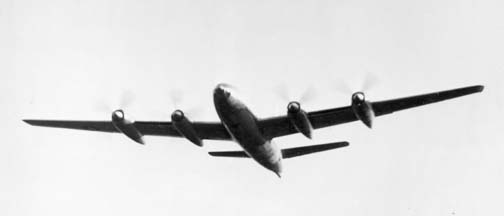 XF-12 Rainbow, 44-91002 on its
first flight on February 4, 1946 over Farmingdale, New York.
Republic Photo via Leo Newman.
XF-12 Rainbow, 44-91002 on its
first flight on February 4, 1946 over Farmingdale, New York.
Republic Photo via Leo Newman.
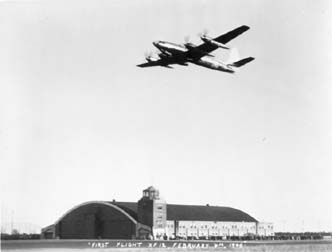 XF-12 Rainbow, 44-91002 on its
first flight on February 4, 1946 over the Republic factory at
Farmingdale, New York. Republic Photo via Leo Newman.
XF-12 Rainbow, 44-91002 on its
first flight on February 4, 1946 over the Republic factory at
Farmingdale, New York. Republic Photo via Leo Newman.
 Rainbow, 44-91002 on its first
flight on February 4, 1946. Republic Photo via Leo Newman.
Rainbow, 44-91002 on its first
flight on February 4, 1946. Republic Photo via Leo Newman.
 Color
photograph of the Republic XF-12 Rainbow in flight.
Color
photograph of the Republic XF-12 Rainbow in flight.
A derivative airliner design, the Republic RC-2, was proposed as a high speed transport. The Rainbow would have filled the market niche that Convair was aiming at with the 880 and Boeing is going for with the Sonic Cruiser. Not quite as big and a bit faster. The Rainbow was over 25% faster than the competition. It was to have been the fastest of the post-war airliners until jet powered airliners were brought into service. Eighteen were ordered by Pan Am, and twenty were ordered by other airlines at $1,250,00 apiece.
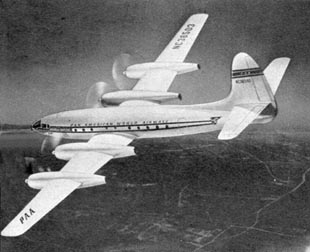 Artist's concept of the Republic RC-2 Rainbow airliner in the
colors of Pan Am from the January 1946 issue of Air News.
Artist's concept of the Republic RC-2 Rainbow airliner in the
colors of Pan Am from the January 1946 issue of Air News.
 Cutaway view of the seating arrangement of the RC-2 Rainbow
airliner.
Cutaway view of the seating arrangement of the RC-2 Rainbow
airliner.
The Air Force eventually decided to use the Boeing B-50 derivative of the B-29 Superfortress for the strategic reconnaissance role instead of the XR-12. The loss of the Air Force production order made the airplane uneconomical to produce in the small quantities that were needed by the airlines. The RC-2 Rainbow went the way of the Convair Model 37 and the Lockheed Constitution when Pan Am and the other airlines cancelled their orders for the airplanes and bought the Boeing 377 Stratocruiser.
One Rainbow crashed on a flight out of Eglin Air Force Base, Florida. The other one ended up as a target at the Aberdeen Proving Grounds, Maryland.
Anigrand has released a cast resin 1/72-scale XF-12 model kit. They are also making use of images from my web site to illustrate theirs without permission or credit.
Collectaire Models is going to release a cast resin 1/48-scale XR-12 model kit in the near future.
Link to the Federation Of American Scientists' page about the Republic XR-12 Rainbow.
Airliners of the Post-War Era |
||||||||
| Type | First Flight | Wing Span | Length | Wing Area (sq ft) | Gross Weight (lb) | Passengers | Cruise Speed (mph) | Engines |
| Lockheed 1049 Super Constellation | 1950 |
123ft,00in |
113ft,07in |
1,650 |
120,000 |
92 |
255 |
4 x 2,700 hp R3350 |
| Bristol Brabazon | 1949 |
230ft,00in |
177ft,00in |
5,317 |
290,000 |
100 |
250 |
8 x 2,650hp Bristol Centaurus |
| Convair XC-99/Model 37 | 1947 |
230ft,00in |
185ft,00in |
4,772 |
320,000 |
204 |
300 |
6 x 3,500hp R4360 |
| Republic XF-12 Rainbow | 1946 |
129ft,02in |
98ft,09in |
1,640 |
113,250 |
46 |
450 |
4 x 3,000hp R4360 |
| Douglas DC-6 | 1946 |
117ft,06in |
100ft,07in |
1,463 |
97,200 |
50 |
328 |
4 x 2,100 hp R2800 |
| Douglas C-74 Globemaster | 1945 |
173ft,03in |
124ft,02in |
2,506 |
145,000 |
108 |
212 |
4 x 3,000hp R4360 |
| Boeing C-97 Stratofreighter/Stratotanker | 1945 |
141ft,03in |
110ft,04in |
1,738 |
120,000 |
4 x 3,000hp R4360 | ||
| Lockheed 049 Constellation | 1943 |
123ft,00in |
95ft,02in |
1,650 |
86,200 |
64 |
275 |
4 x 2,000 hp R3350 |
| Douglas DC-4 | 1942 |
117ft,06in |
93ft,10in |
1,460 |
73,000 |
44 |
227 |
4 x 1,350 hp R2000 |
Send a message to Brian